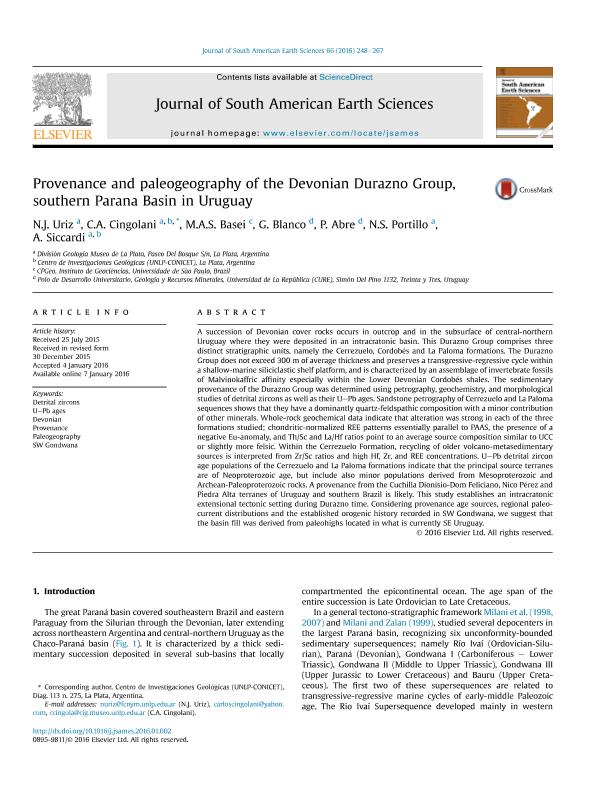Mostrar el registro sencillo del ítem
dc.contributor.author
Uriz, Norberto Javier

dc.contributor.author
Cingolani, Carlos Alberto

dc.contributor.author
Basei, M.A.S.
dc.contributor.author
Blanco, G.
dc.contributor.author
Abre, P.
dc.contributor.author
Portillo, N.S.
dc.contributor.author
Siccardi, Aron

dc.date.available
2018-06-19T18:18:30Z
dc.date.issued
2016-03
dc.identifier.citation
Uriz, Norberto Javier; Cingolani, Carlos Alberto; Basei, M.A.S.; Blanco, G.; Abre, P.; et al.; Provenance and paleogeography of the Devonian Durazno Group, southern Parana Basin in Uruguay; Pergamon-Elsevier Science Ltd; Journal of South American Earth Sciences; 66; 3-2016; 248-267
dc.identifier.issn
0895-9811
dc.identifier.uri
http://hdl.handle.net/11336/49362
dc.description.abstract
A succession of Devonian cover rocks occurs in outcrop and in the subsurface of central-northern Uruguay where they were deposited in an intracratonic basin. This Durazno Group comprises three distinct stratigraphic units, namely the Cerrezuelo, Cordobés and La Paloma formations. The Durazno Group does not exceed 300 m of average thickness and preserves a transgressive-regressive cycle within a shallow-marine siliciclastic shelf platform, and is characterized by an assemblage of invertebrate fossils of Malvinokaffric affinity especially within the Lower Devonian Cordobés shales. The sedimentary provenance of the Durazno Group was determined using petrography, geochemistry, and morphological studies of detrital zircons as well as their U-Pb ages. Sandstone petrography of Cerrezuelo and La Paloma sequences shows that they have a dominantly quartz-feldspathic composition with a minor contribution of other minerals. Whole-rock geochemical data indicate that alteration was strong in each of the three formations studied; chondritic-normalized REE patterns essentially parallel to PAAS, the presence of a negative Eu-anomaly, and Th/Sc and La/Hf ratios point to an average source composition similar to UCC or slightly more felsic. Within the Cerrezuelo Formation, recycling of older volcano-metasedimentary sources is interpreted from Zr/Sc ratios and high Hf, Zr, and REE concentrations. U-Pb detrital zircon age populations of the Cerrezuelo and La Paloma formations indicate that the principal source terranes are of Neoproterozoic age, but include also minor populations derived from Mesoproterozoic and Archean-Paleoproterozoic rocks. A provenance from the Cuchilla Dionisio-Dom Feliciano, Nico Pérez and Piedra Alta terranes of Uruguay and southern Brazil is likely. This study establishes an intracratonic extensional tectonic setting during Durazno time. Considering provenance age sources, regional paleocurrent distributions and the established orogenic history recorded in SW Gondwana, we suggest that the basin fill was derived from paleohighs located in what is currently SE Uruguay.
dc.format
application/pdf
dc.language.iso
eng
dc.publisher
Pergamon-Elsevier Science Ltd

dc.rights
info:eu-repo/semantics/openAccess
dc.rights.uri
https://creativecommons.org/licenses/by-nc-sa/2.5/ar/
dc.subject
Detrital Zircons
dc.subject
Devonian
dc.subject
Paleogeography
dc.subject
Provenance
dc.subject
Sw Gondwana
dc.subject
U-Pb Ages
dc.subject.classification
Meteorología y Ciencias Atmosféricas

dc.subject.classification
Ciencias de la Tierra y relacionadas con el Medio Ambiente

dc.subject.classification
CIENCIAS NATURALES Y EXACTAS

dc.title
Provenance and paleogeography of the Devonian Durazno Group, southern Parana Basin in Uruguay
dc.type
info:eu-repo/semantics/article
dc.type
info:ar-repo/semantics/artículo
dc.type
info:eu-repo/semantics/publishedVersion
dc.date.updated
2018-06-18T21:23:59Z
dc.journal.volume
66
dc.journal.pagination
248-267
dc.journal.pais
Países Bajos

dc.journal.ciudad
Amsterdam
dc.description.fil
Fil: Uriz, Norberto Javier. Consejo Nacional de Investigaciones Científicas y Técnicas; Argentina. Universidad Nacional de la Plata. Facultad de Ciencias Naturales y Museo. División geología; Argentina
dc.description.fil
Fil: Cingolani, Carlos Alberto. Consejo Nacional de Investigaciones Científicas y Técnicas. Centro Científico Tecnológico Conicet - La Plata. Centro de Investigaciones Geológicas. Universidad Nacional de La Plata. Facultad de Ciencias Naturales y Museo. Centro de Investigaciones Geológicas; Argentina. Universidad Nacional de la Plata. Facultad de Ciencias Naturales y Museo. División geología; Argentina
dc.description.fil
Fil: Basei, M.A.S.. Universidade de Sao Paulo; Brasil
dc.description.fil
Fil: Blanco, G.. Universidad de la República; Uruguay
dc.description.fil
Fil: Abre, P.. Universidad de la República; Uruguay
dc.description.fil
Fil: Portillo, N.S.. Universidad Nacional de la Plata. Facultad de Ciencias Naturales y Museo. División geología; Argentina
dc.description.fil
Fil: Siccardi, Aron. Consejo Nacional de Investigaciones Científicas y Técnicas. Centro Científico Tecnológico Conicet - La Plata. Centro de Investigaciones Geológicas. Universidad Nacional de La Plata. Facultad de Ciencias Naturales y Museo. Centro de Investigaciones Geológicas; Argentina. Universidad Nacional de la Plata. Facultad de Ciencias Naturales y Museo. División geología; Argentina
dc.journal.title
Journal of South American Earth Sciences

dc.relation.alternativeid
info:eu-repo/semantics/altIdentifier/doi/https://dx.doi.org/10.1016/j.jsames.2016.01.002
dc.relation.alternativeid
info:eu-repo/semantics/altIdentifier/url/https://www.sciencedirect.com/science/article/pii/S0895981116300025
Archivos asociados
